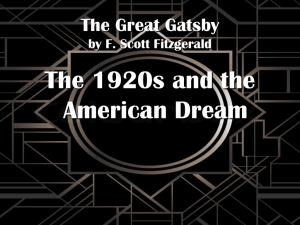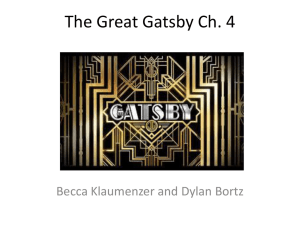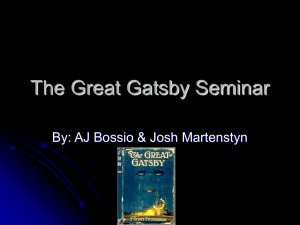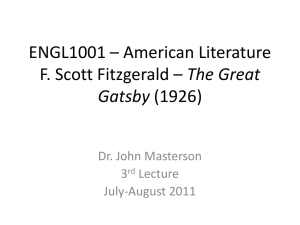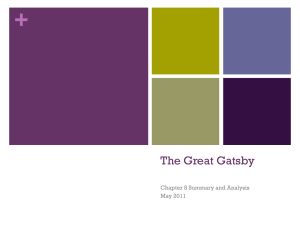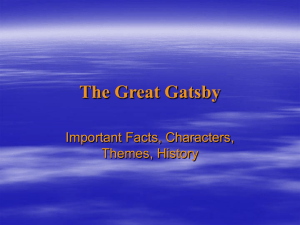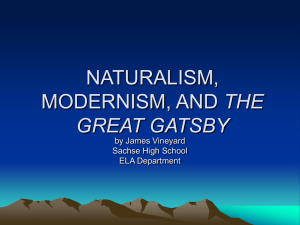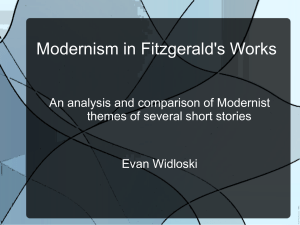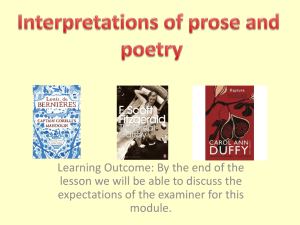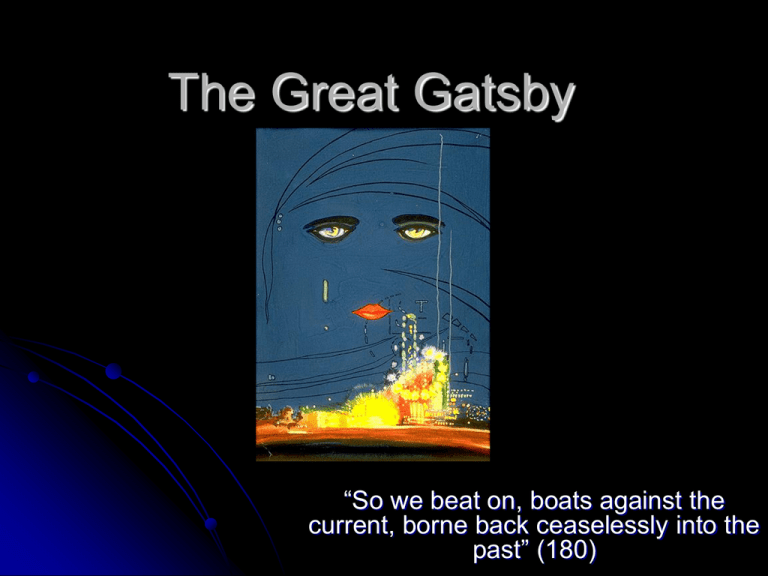
The Great Gatsby
“So we beat on, boats against the
current, borne back ceaselessly into the
past” (180)
Map of West Egg & East Egg
Color Symbolism
Green:
White:
Ideal happiness, perfection, promise of the dream, realizing dream, or fantasy of dream
Grey:
Corruption, death, old wealth, real $, the materialism/values that destroys dream
Blue:
Purity, innocence, honesty, the perfection of the dream, ultimate bliss, vision of dream
Yellow/Gold:
Hope, limitless promise of the dream, the dream itself
Hopelessness, no money, wanting a better life, moral decay
Red:
Ugliness of reality, gaudiness of dream, violent nature of people/dream
Chapter 1
East Egg = Established wealth
West Egg = New Rich, Imitation, Flashy
“it was a factual imitation of some Hotel de Ville in Normandy” (5)
Nick is from the Midwest
“A cheerful red-and-white Georgian Colonial mansion.” (6)
Modest, Humble, Morally sound, Stability. Nick rents a bungalow
The main conflict & theme in the story is between
Gatsby’s dream and the disgusting reality
[West Egg vs. East Egg]
Fitzgerald focuses on the American Dream—its hopes, illusions,
corruption, self-discovery, possessiveness, and paradox
Chapter 1
Nick: narrator
Daisy & Tom:
Says he reserves judgment but will judge each character
throughout.
Only Character that undergoes any sort of change because of
his established roots…others are aimlessly drifting to find social
and materialistic wealth.
Represent shallowness and arrogance of wealthy
They have $ but do not have a purpose in life
Hopelessness… “the best thing a girl can be in this world, a
beautiful little fool.” (17)
Glamour, Appearances, & Money cover up inner emptiness
Chapter 2
This introduces the “foul dust” that destroys Gatsby’s dream
Ashes are all over the entire chapter:
Ashes are symbolic of the moral decay and spiritual desolation
The apartment scene is a great example of how $ has destroyed people
Valley of Ashes {between West Egg & East Egg}
Dust on Wilson’s wrecked Ford, and his hair and clothes
Catherine's powdered face
“the gray land and spasms of bleak dust which drift endlessly over it.” (23)
Represents the foul, material driven world the characters live in
Implies that under the glamour of the rich is nothingness
Home to the only poor people in book
The Eyes of Dr. T.J. Eckleberg
Advertising & materialism gone mad
God looking out over the decay of people in the 1920’s
Faded eyes might suggest the fading emphasis on religion
Blue eyes represent idealism or perfection
Gold glasses represent the corruption
Chapter 2
New York Apartment Party
Tom’s hypocrisy, selfishness, and brutality are highlighted
Tom views Myrtle as his possession rather than a person
Nick is disgusted by the party, but is also fascinated
Myrtle’s transformation in New York
Brown dress into a Cream Chiffon (represents change in values)
She wants to escape her social class (compromising morals for $)
“With the influence of the dress her personality had also undergone a
change.” (30)
Obsessed with appearances…she hates husband for marrying on looks
but did the same thing with Tom on the train.
The list of things she wants shows her shallow character: dog collar,
trick ashtray, and a wreath for her mothers grave [all of equal value??]
Perfect for Tom: she is the same money stained-dream girl like Daisy
Chapter 3
Nick describes Gatsby’s parties
Fitzgerald sets the party’s beauty against harsh reality [car accident]
Accident is and example of the guest’s careless actions and morals
Gatsby
Nick notes Gatsby’s speech & manner don’t fit his world he created
He stays distant from his guests as part of his plan to achieve dream
A means to an end [he does not want to be part of this corruptive group of people in
order to remain faithful to his goal]
Nick and Jordan’s Relationship
Nick realizes Jordan’s selfishness and dishonesty, yet still pursues her
This shows how Nick rejects his Midwestern morals for Eastern “fun”
Fitzgerald uses this relationship to explain how people go away from
their morals in order to impress the opposite sex or fit in with society
Chapter 4
Gatsby reveals more of his “story”
This adds to the admiration of Gatsby
He has gone to great lengths to create an ideal
Green light is on Daisy’s dock
Feels he can win Daisy back with his wealth
Daisy’s Story
Was in love with Gatsby in Louisville before he went to war
Daisy wanted to go to see him off but was denied
Drunken wedding day characteristic of her indecisiveness
Daisy marries Tom for the security of wealth but not happy
Chapter 4
Main conflict w/ Gatsby’s character revealed
His friendship w/ Wolfsheim implies Gatsby’s wealth may not be
coming from legal sources
Jordan’s story of Gatsby & Daisy reveals his romantic dream to win
the girl of his dreams back.
Bootlegging or organized crime (Wolfsheim fixed world series)
“Gatsby bought that house so that Daisy would be just across the bay.”
(83)
Green light Gatsby reaches for in Ch. 1 is at Daisy’s dock in East Egg
Green Light is symbol of Gatsby’s Dream & American Dream
Gatsby has obtained wealth (illegally?) to get Daisy back
We have to recognize the romantic element to this, yet question the
means with which he has gone about it. [Is Gatsby good or bad?]
Chapter 5
Pivotal chap. because Gatsby’s dream is realized
Everything after the meeting is meaningless
Daisy cannot live up to his expectations [unrealistic dream]
“…Daisy tumbled short of his dreams-not through her own fault but because of
the colossal vitality of his illusion.” (101)
Gatsby doesn’t realize dream cannot be realized
“Possibly it had occurred to him that the colossal significance of that light had now
vanished forever.” (98)
Daisy cannot be bought & is not worthy of his goal
Nothing but Daisy matters, no material object holds any meaning
Even if he has Daisy nothing will live up to the spirituality of his idea
Gatsby is greater than the society he portrays [wealth was for Daisy]
American Dream’s enchanting promise cannot be matched by materialism
Chapter 6
Embarrassed of his social standing Jay Gatz creates “The Great Gatsby”
The Party is the beginning of the disintegration of Gatsby’s dream
Dan Cody is everything Gatz wants to be
Through his character Gatsby he can create the life he wants
Gatsby fails to see how wealth leads to self-destruction w/ Cody’s death
Gatsby is faithful to a fault in his quest for happiness
Daisy does not like nor understand the guests [Old Money vs. New Money]
Tom is critical of Gatsby, the guests, and Daisy
Even though Gatsby is rich, he will never be a part of Tom & Daisy’s world
Gatsby is Hopelessly Devoted to his dream
“Can’t repeat the past?’ he cried incredulously. ‘Why of course you can!” (116)
Nick respects the romantic, honorable passion Gatsby has for his dream
But since the dream is now ‘reality’ it takes on limitations and dissolves
Chapter 7&8 Levels of Questions
Literal: Answers to literal level questions have answers found right in the
book.
Example: Why does George shoot Gatsby?
Interpretive: In order to answer interpretive questions, readers must look up
multiple parts of a text.
Example: How does Gatsby’s dream lead to his death?
The answer to this question can be found in a single quote from the novel.
Events from multiple parts of the text, related to Gatsby’s hopeless devotion to his dream,
must be understood and analyzed to answer this question.
Experienced Based: An answer to this question can be formulated by
analyzing multiple texts or analyzing real-world situations. Likewise, this
question can be applied to multiple texts and multiple real-world situations.
Example: How do dreams drive a person to be the best person he/she can be or
the worst?
This question can be answered by analyzing Old Man & the Sea, A Raisin in the Sun, and
The Great Gatsby. Likewise, this question can be applied to all of these texts. Also, this
question can be answered by looking at real life situations.
Chapter 7
This focuses on the end of Gatsby’s dream
No more parties
Daisy thinks of her and Gatsby’s affair as a game
Daisy cannot say she never loved Tom
She wants to maintain the status quo but entertain with Gatsby
Turning to Tom represents her devotion to him & end of Gatsby
Tom realizes his victory so he sends Daisy home w/ Gatsby
Myrtle’s death forces Nick to judgment
Pammy throws Gatsby off & destroys hope of returning to past
At the hotel suite is where Daisy betrays Gatsby’s dream
Buchanans are careless & empty
Nick abandons Buchanans, Jordan, & the East
Gatsby watches over Daisy’s empty room = Emptiness of Dream
Chapter 8
Gatsby remains loyal to the end to his dream & Daisy
Excuses her actions from day before
“he found that had committed himself to the following of a grail” (149)
Upholds the nobility of dream and is why Nick and the reader like him
Cannot be realized due to pursuit of material wealth by Gatsby & Daisy
“What was the use of doing great things if I could have a
better time telling her what I was going to do?” (150)
Daisy is portrayed as weak and unwilling to wait
“She wanted her life shaped now, immediately…” (151)
Nick no longer reserves judgment, he says Gatsby is “worth the whole damn
bunch put together.”
Chapter 8
Wilson’s lack of spiritual value leads him to mistaking Dr. T.J.
Eckleburg’s eyes as the eyes of God.
Searching for meaning he misinterprets & thinks revenge is justified
Gatsby dies with his faith intact-waiting for the call from Daisy
This affirms that there is more to life than money, wealth, etc.
“He must of looked up at an unfamiliar sky through frightening leaves
and shivered as he found what a grotesque thing a rose is…” (161)
Just because something appears beautiful or someone says it is doesn’t
mean that it is or right for you.
We create meaning with different objects but once they lose their
meaning…we cannot re-create it (like we cannot re-create the past).

